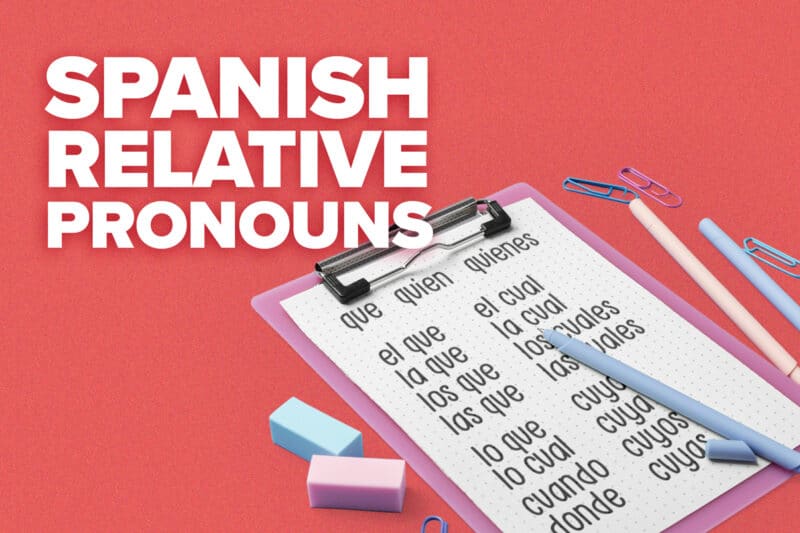Using Relative Pronouns in Spanish (Plus the 9 Main Ones)

Relative pronouns in Spanish may not sound like the most fun subject, but they’re actually super useful (and required!), so it’s a good idea to get them down early.
This post will introduce you to the 9 different Spanish relative pronouns and how to use them correctly, so your sentences connect together more smoothly and you sound more fluent!
Download: This blog post is available as a convenient and portable PDF that you can take anywhere. Click here to get a copy. (Download)
What is a Spanish Relative Pronoun?
A relative pronoun in Spanish is a word that refers back to a noun that comes before it, which is called the antecedent.
Relative pronouns in Spanish are words used to introduce relative clauses, also known as dependent clauses, which are clauses that contain additional information about the main verb, but cannot stand alone as complete sentences. Relative clauses answer questions, like:
- Which man?
- What dog?
- Which car?
- Whose birthday?
Relative pronouns replace the noun and link the main clause (the main sentence) with the relative clause. They are placed directly before the verb in relative clauses.
The Spanish relative pronouns are:
| Relative Pronouns | English | Example Sentence | English |
|---|---|---|---|
| que | that, which, who | La casa que compramos es muy grande. | The house that we bought is very big. |
| quien | who, whom | María, quien vive en esa casa, es muy amable. | Maria, who lives in that house, is very kind. |
| el que | that, which, who | El libro el que te di está en la mesa. | The book that I have you in on the table. |
| el cual | that, which, who | El proyecto, con el cual estamos trabajando, es muy importante. | The project on which we're working in very important. |
| lo que | what, which | No entiendo lo que dices. | I don't understand what you're saying. |
| lo cual | what, which | Había una situación difícil, lo cual complicaba todo. | There was a difficult situation, which complicated everything. |
| cuyo | whose | El hombre, cuyo coche se averió, estaba preocupado. | The man, whose car broke down, was worried. |
| cuando | when | El día cuando nos conocimos fue muy especial. | The day when we met was very special. |
| donde | where | Este es el lugar donde nos conocimos. | This is the place where we met. |
Keep in mind that these pronouns (with the exception of que, cuando and donde) have different forms, depending on the gender and number of the noun they’re referring to.
In this example sentence…
Él es el hombre que vino ayer. (He is the man who came yesterday.)
Él es el hombre (he is the man) is the first clause. If you just left it as is, this phrase would make no sense.
Which man are you referring to?
This is where the relative pronoun comes in: que is able to link the first clause to the second clause, vino ayer.
The que is able to clarify who we are actually talking about!
Facts About Relative Pronouns in Spanish
- You cannot omit the relative pronoun. In English, we tend to leave out the relative pronoun (for example: I bought the pizza [that] you like), but in Spanish you must always include the relative pronoun.
- You must keep relatives and prepositions together, unlike in English. If we look at the sentence “The park in which we are is very big,” we know that in English, you could also say “The park we are in is very big.” In Spanish, we cannot rearrange the relative pronouns to write the sentence differently. This sentence will always be written as El parque en el que estamos es muy grande.
- Spanish has more options for relative pronouns than English. English relative pronouns are usually rather straightforward as they are used in certain situations. Spanish, however, has a plethora of options when it comes to which relative pronoun to use.
The Main Relative Pronouns in Spanish
1. Que — That, Which, Who
Que is practically universal in Spanish because it can refer to people, animals and things, both in the singular and in the plural.
Although it can be translated as “which” and “who,” que can be better compared to “that” in English because of its universality:
Los libros que encargaste acaban de llegar. — The books that you ordered have just arrived.
El perro que ves allí es mío. — The dog that you see over there is mine.
2. Quien — Who, Whom
Quien and its plural form quienes are used to refer back to people. These are the Spanish equivalents of the English pronoun “who” and “whom.”
Use quien when you have a one-word preposition (en, con, a, de, sin, para, etc.) before the relative pronoun and the antecedent is a person. You need to have both the preposition and the person, or the sentence will be grammatically incorrect.
Here are two examples:
Los hombres con quienes está María han venido a verte. — The men María is with have come to see you.
Las chicas a quienes regalé rosas son hermanas. — The girls I gave roses to are sisters.
Note that since the antecedent verbs are plural, the relative pronouns are plural, too.
3. El Que — That, Which, Who
El que is almost as universal as que and has multiple forms depending on number and gender: el que, la que, los que, and las que. It can be used with people, animals and things and it agrees in gender and number with the antecedent.
However, there is a little difference between que and the el que forms. El que forms require a preposition to appear in a sentence.
El que and quien also mean the same thing, but remember that while quien needs a one-word preposition (or para), el que can make use of any preposition in the Spanish language.
Let’s have a look at some examples:
El libro del que te hablé es “Alicia en el País de las Maravillas.” — The book I told you about is “Alice in Wonderland.”
Los niños para los que estamos construyendo este hospital tienen cáncer. — The children for whom we are building this hospital have cancer.
Estas son las cosas sobre las que suelo leer. — These are the things I used to read about.
4. El Cual — That, Which, Who
The el cual group means exactly the same thing as the el que group and also has different forms depending on number and gender: el cual, la cual, los cual, and las cual. We can use it with people, animals and things, and depending on the antecedent, you will have to change the form.
El cual forms also need a preposition to appear in a sentence, so we can safely say that you can use the el que and el cual groups interchangeably.
There are two little things you need to remember:
- El cual is used almost exclusively in formal language.
- Even though both el que and el cual groups work with any Spanish preposition, there is a tendency to use el cual when dealing with compound prepositions.
A compound preposition is a simple preposition accompanied by another word that’s needed to explain the relationship. For example cerca means “close” but is usually paired with de to make the compound preposition cerca de (close to).
It would be impossible to mention all the compound prepositions in the Spanish language, but here are some examples so that you can see the el cual group at work:
Esta es la ventana a través de la cual saltó el ladrón. — This is the window through which the robber jumped.
Las chicas junto a las cuales está mi esposa son mis hijas. — The girls to whom my wife is close are my daughters.
Los coches delante de los cuales has aparcado son de Francia. — The cars in front of which you have parked are from France.
5. Lo Que — What
Lo que and lo cual are neuter relative pronouns, so they will not refer to any specific masculine or feminine antecedent (the noun described by the previous clause), but to a situation, a concept or a whole sentence.
You have to use lo que when you don’t have an antecedent in the sentence:
No puedo decirte lo que quieres oír porque sería una mentira. — I cannot tell you what you want to hear because it would be a lie.
6. Lo Cual — Which
Lo cual works the same as lo que, but for sentences that contain an antecedent.
Keep in mind that if you already have an antecedent in the sentence you can use either of them, and both will be correct:
Llegamos muy tarde, lo cual preocupó a mamá.
— We came back very late, which worried Mom.
Llegamos muy tarde, lo que preocupó a mamá.
— We came back very late, which worried Mom.
6. Cuyo — Whose
I have included cuyo (whose) in this post because it is a relative. However, cuyo is not actually a relative pronoun, but a relative adjective.
And as every adjective in Spanish, it has to agree in number and gender with a noun.
But (and please pay attention because this is utterly important) cuyo and its forms don’t agree with the antecedent, but with the noun they modify.
Here you have some examples:
En un lugar de la Mancha, de cuyo nombre no quiero acordarme… — In a village of La Mancha, the name of which I have no desire to call to mind…
La casa cuyas ventanas son verdes es de mi hermano. — The house of which the windows are green is my brother’s.
Este es Mario, cuyos libros han sido vendidos en todo el mundo. — This is Mario, whose books have been sold worldwide.
Unlike English, where you use “whose” or “which” also to ask about the owner of an object or the relation of a person with another, you cannot make questions in Spanish by using cuyo. Instead, you will need to use ¿De quién?:
¿De quién es este paraguas? — Whose umbrella is this?
¿De quién son estos libros? — Whose books are these?
7. Cuando — When
This adverb can also be used as a relative pronoun.
You need to remember that cuando, when working as a relative pronoun, is not a question word, so you cannot use the accent mark. Have a look:
No recuerdo el momento cuando te vi por primera vez. — I cannot remember the moment when I saw you for the first time.
9. Donde — Where
Donde works the same way as cuando.
Esta es la escuela donde enseñaba mi madre. — This is the school where my mom used to teach.
How to Practice Spanish Relative Pronouns
The quickest way to learn Spanish relative pronouns is to practice them as much as possible. Here are some tips and resources to help you do just that:
- Do activities and exercises. You can find some interesting practice exercises here and here. Doing these types of exercises help you practice applying concepts yourself.
- Try virtual immersion. There are several ways of doing this, either on your own or with language learning programs. FluentU, for example, uses short, culturally-relevant videos made by native speakers along with interactive subtitles to teach Spanish. It makes it easier to spot these relative pronouns (and other elements of the language) while you’re hearing them used in context. Plus, FluentU is available on iOS or Android.
- Read a Spanish book. Reading Spanish books is a great way to immerse yourself in the language and you’re sure to pick up on a lot of relative pronouns as well as other vocabulary and grammar concepts.
- Watch a Spanish movie. Not only are movies entertaining, but you’ll be able to listen for those relative pronouns and hear how they’re used in natural speech.
- Practice incorporating them into your own speech. The best way to learn how to use Spanish relative pronouns is to try using them yourself. By speaking them out loud, you’ll get a grasp on how they fit into sentences. I recommend finding a native speaker to have a conversation with so they can give you feedback on your speech!
Using relatives will make your speech and writing more fluid, so I hope this post will help you take the next step down your road to fluency!
Download: This blog post is available as a convenient and portable PDF that you can take anywhere. Click here to get a copy. (Download)
And One More Thing…
If you've made it this far that means you probably enjoy learning Spanish with engaging material and will then love FluentU.
Other sites use scripted content. FluentU uses a natural approach that helps you ease into the Spanish language and culture over time. You’ll learn Spanish as it’s actually spoken by real people.
FluentU has a wide variety of videos, as you can see here:

FluentU brings native videos within reach with interactive transcripts. You can tap on any word to look it up instantly. Every definition has examples that have been written to help you understand how the word is used. If you see an interesting word you don’t know, you can add it to a vocab list.

Review a complete interactive transcript under the Dialogue tab, and find words and phrases listed under Vocab.

Learn all the vocabulary in any video with FluentU’s robust learning engine. Swipe left or right to see more examples of the word you’re on.

The best part is that FluentU keeps track of the vocabulary that you’re learning, and gives you extra practice with difficult words. It'll even remind you when it’s time to review what you’ve learned. Every learner has a truly personalized experience, even if they’re learning with the same video.
Start using the FluentU website on your computer or tablet or, better yet, download the FluentU app from the iTunes or Google Play store. Click here to take advantage of our current sale! (Expires at the end of this month.)








